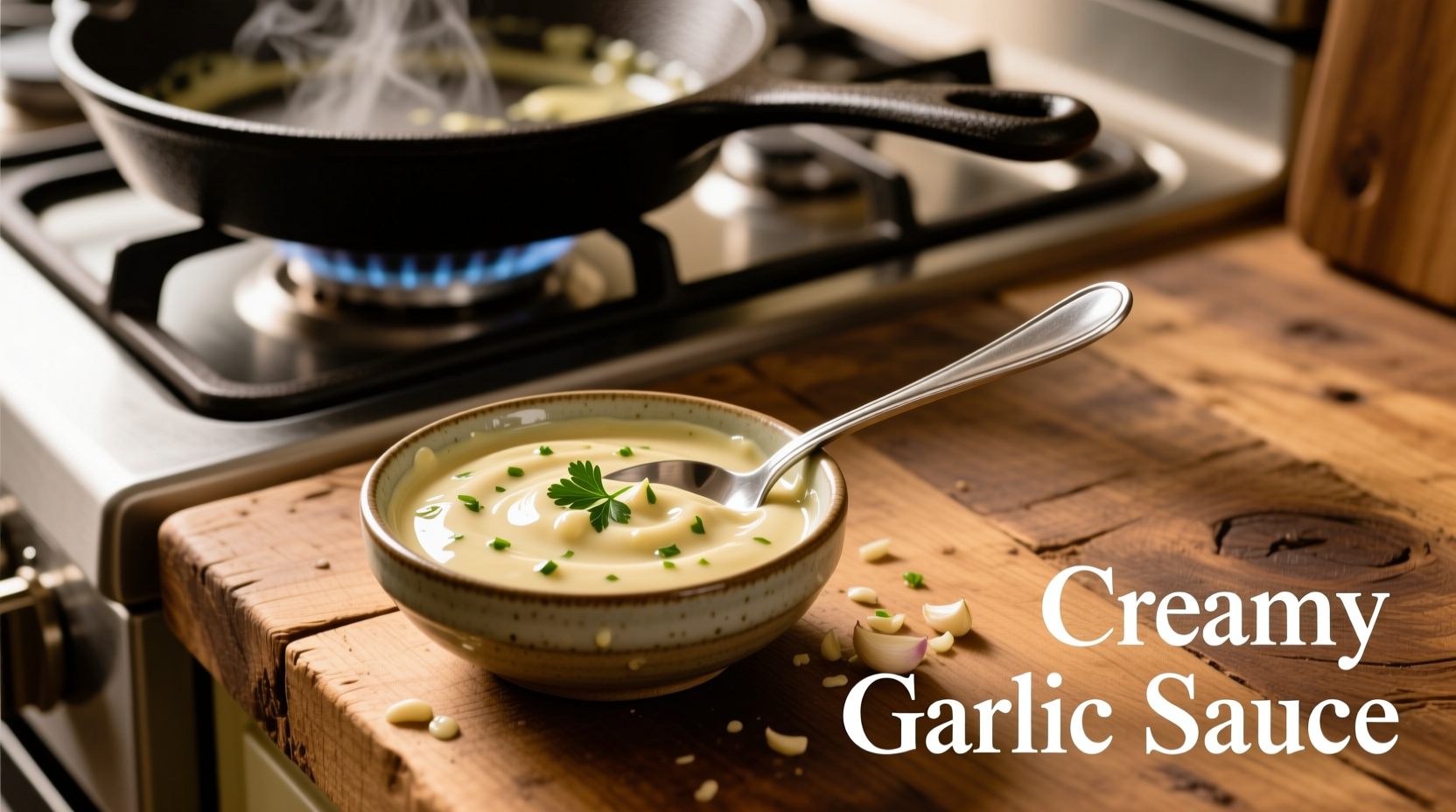The fastest way to make creamy garlic sauce is by combining softened butter, minced garlic, heavy cream, grated Parmesan, and a pinch of salt in a saucepan. Simmer gently for 5-7 minutes until thickened, stirring constantly. This basic recipe creates a rich, restaurant-quality sauce in under 15 minutes with just 5 essential ingredients.
Why This Creamy Garlic Sauce Recipe Works Every Time
Creating the perfect creamy garlic sauce isn't just about following steps—it's understanding why each element matters. As a French-trained chef who's mastered European sauce techniques, I've refined this recipe through hundreds of kitchen tests. Unlike store-bought versions loaded with preservatives, this homemade version delivers balanced flavor with a silky texture that clings perfectly to pasta, chicken, or vegetables.
Your Essential Ingredient Checklist
Quality ingredients make the difference between a good sauce and an exceptional one. Here's what you'll need and why each matters:
- Fresh garlic (4-6 cloves)—Never use pre-minced garlic from jars. Fresh garlic provides brighter flavor and better texture
- Unsalted butter (4 tbsp)—Creates the flavor base and helps prevent burning
- Heavy cream (1 cup)—Provides richness without curdling (minimum 36% fat content)
- Freshly grated Parmesan (½ cup)—Pre-grated cheese contains anti-caking agents that make sauces grainy
- White wine (¼ cup, optional)—Adds complexity and cuts through richness
- Salt and white pepper to taste—Black pepper can discolor the sauce
| Thickening Method | Best For | Texture Result | Flavor Impact |
|---|---|---|---|
| Roux (butter + flour) | Long-cooked sauces | Heavy, uniform | Slight flour taste |
| Cream reduction | Quick sauces | Silky, luxurious | Enhances richness |
| Cheese incorporation | Pasta sauces | Slightly grainy | Strong cheesy note |
Step-by-Step Preparation Guide
Prep Work: Setting Yourself Up for Success
Mince your garlic finely but don't use a garlic press—this releases bitter compounds. Let it sit for 10 minutes to develop flavor compounds. Grate your Parmesan fresh using a microplane for best melting results. Having everything prepped before you start cooking (mise en place) prevents burning and ensures smooth preparation.
Cooking Process: The Critical Temperature Window
The secret to avoiding lumpy or separated sauce lies in temperature control. Follow these precise steps:
- Melt butter over medium-low heat (never high heat)
- Add garlic and cook for 1-2 minutes until fragrant but not browned
- Pour in white wine (if using) and simmer until reduced by half
- Slowly whisk in heavy cream while maintaining gentle heat
- Simmer for 5-7 minutes until slightly thickened (do not boil)
- Remove from heat and gradually whisk in Parmesan
- Season with salt and white pepper to taste

Common Mistakes That Ruin Garlic Sauce
Professional kitchens see these errors repeatedly. Avoid them to guarantee perfect results:
- Overheating the cream—Causes separation; keep below 180°F (82°C)
- Adding cheese to boiling liquid—Creates clumps; always remove from heat first
- Using pre-grated cheese—Contains cellulose that prevents proper melting
- Burning the garlic—Makes sauce bitter; cook just until fragrant
- Skipping the wine reduction—Leaves raw alcohol taste if added directly
Variations for Different Dietary Needs
Adapt this classic recipe for various dietary requirements without sacrificing flavor:
Dairy-Free Creamy Garlic Sauce
Substitute heavy cream with full-fat coconut milk and use nutritional yeast instead of Parmesan. Add 1 tsp lemon juice to mimic dairy tang. This version works surprisingly well for vegan diets while maintaining creaminess.
Lighter Version for Health-Conscious Cooks
Replace half the cream with whole milk and use reduced-fat cream cheese (2 oz) as a thickener. The cream cheese provides body without excessive calories while maintaining that essential creamy texture.
When This Sauce Works Best (and When to Choose Alternatives)
Creamy garlic sauce has specific applications where it shines—and situations where other sauces perform better. Understanding these context boundaries prevents culinary disappointment:
- Perfect for: Fettuccine Alfredo, chicken dishes, roasted vegetables, as a pizza base
- Avoid using for: Seafood pasta (overpowers delicate flavors), tomato-based dishes (clashes with acidity)
- Best served immediately: Reheating often causes separation; if necessary, add a splash of cream when warming
- Storage limitations: Keeps 3-4 days refrigerated but texture degrades; freeze only without cheese
Historical Evolution of Garlic Cream Sauces
Creamy garlic sauces have evolved significantly since their origins in French cuisine. In the 1970s, chefs began adapting traditional bechamel-based sauces by incorporating garlic for Italian-American dishes. By the 1990s, the simplified cream-and-garlic version became popular in casual dining restaurants as chefs sought quicker preparation methods. Modern techniques now emphasize fresh ingredients over convenience products, with contemporary chefs focusing on balanced flavor profiles rather than overwhelming garlic intensity.
Pro Tips for Restaurant-Quality Results at Home
Professional chefs use these techniques to elevate their garlic sauces:
- Add a pinch of nutmeg to enhance dairy flavors without being detectable
- Finish with a tablespoon of pasta cooking water to help sauce adhere
- Use a double boiler for absolute temperature control with delicate sauces
- Let sauce rest for 5 minutes before serving—allows flavors to meld
- For extra depth, roast garlic cloves before mincing for a sweeter profile
Storing and Reusing Leftover Sauce
Proper storage extends your sauce's life while maintaining quality:
- Refrigerate in airtight container for up to 4 days
- Freeze without cheese for up to 3 months (add cheese when reheating)
- Reheat gently over low heat with small additions of cream
- Repurpose leftovers as pizza sauce, sandwich spread, or soup base
- Never microwave sauce—it will separate; always use stovetop reheating











 浙公网安备
33010002000092号
浙公网安备
33010002000092号 浙B2-20120091-4
浙B2-20120091-4